If you think you only need to choose a bunch of aleatory keywords to design an SEO content strategy for your website, you are very wrong!
The truth is that search engine optimization requires efficient use and understanding of keywords, so you need to assign them to each page after finding and selecting the terms that better match the user search intent you want to answer on your page. How to do this assignment? Well, you need to keyword map your site.
Today I will answer what keyword mapping is and how to do it, its benefits for your website, and more!
Don’t miss it!
- What Is Keyword Mapping?
- What Is The Goal Of SEO Keyword Mapping?
- 9 Benefits Of Keyword Mapping
- 1. You create a better architecture for your site
- 2. It helps you organize your keywords in groups
- 3. It helps you to discover new keywords meaning
- 4. It improves communication in the content creation process
- 5. You don’t create duplicate content
- 6. Identify keyword gaps in your content strategy
- 7. You create content with search intent in mind
- 8. It allows you to find internal linking opportunities
- 9. You can prioritize better search engines’ optimization efforts
- Keyword Mapping In 5 Easy Steps
- Some Tips To Keep In Mind When Doing Your Keyword Map
- That’s All For today!
- Frequently Asked Questions
What Is Keyword Mapping?
Keyword mapping is the process of determining the best place for groups of semantic keywords (short tail, middle tail, long tail keywords) in a logical way on each of the pages and product categories of your website and taking into account the results of your keyword search.

Each page’s SEO keyword mapping often includes a primary focus keyword according to the topic it addresses and two to three variations in your keyword research.
There are three main selection criteria when choosing the right target keywords per page:
- The words that align with your website’s IA (information architecture).
- The words that align with your SEO strategy.
- The words that are not too competitive.
- The words that people use in their queries.
Keyword mapping aims to get specific ideas or recommendations for building a more solid SEO content strategy for each page. It helps you to create relevant content around a set of keywords; you will know which keywords go in each section of your page.
For example, you will know what words assign to the titles, meta description, categories, subcategories, the body of the page, cluster content, etc.
Pro tip:
Create a spreadsheet in which you include the pages of your website one by one, create columns with each of your website’s sections, and indicate the keywords you will use. Remember that they must keep a semantic and logical relationship between them.
What Is The Goal Of SEO Keyword Mapping?
The main goal of SEO keyword mapping is to help you understand the specific purpose of each page and create a more solid web architecture that will increase your chances of search engine rankings by matching group keywords for a particular URL.
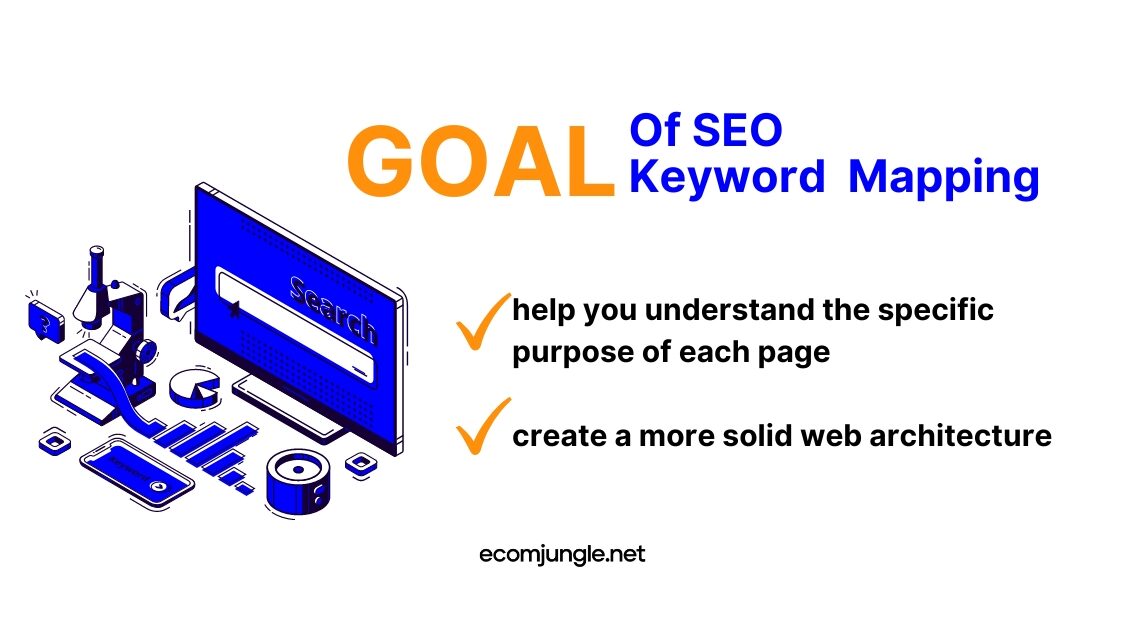
The keyword mapping process helps you find and assign the right place within your page to the main keyword and its variations, according to its relevance for the topic, your business, and your audience, to create a more effective SEO strategy.
9 Benefits Of Keyword Mapping
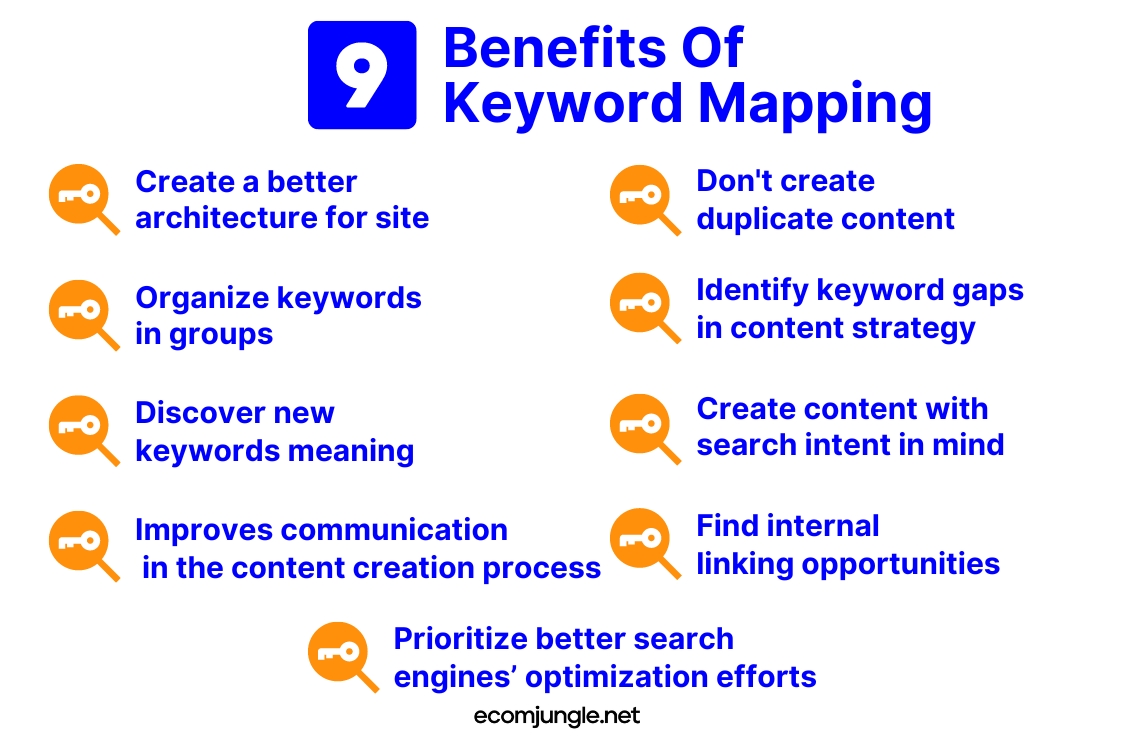
If you are not convinced to start keyword mapping your website, here are the main benefits:
1. You create a better architecture for your site
Keyword mapping helps you understand each page’s purpose on your website, why it is there, and what you are trying to achieve.
2. It helps you organize your keywords in groups
Keyword maps are essential for creating SEO-friendly content for each page, as each page will include a group of semantic keywords ordered logically by theme. Hence, you know the main focus word and variations.
3. It helps you to discover new keywords meaning
It is a derivation of the previous keyword mapping benefit since organizing and grouping words allow you to make links between them to obtain meanings that, individually or on their own, they did not have to give a higher level of relevance.
4. It improves communication in the content creation process
So that everyone on your team sees what each page is supposed to be optimized for. A large team dealing with content and pages across the entire website can sometimes lead to situations where some team members don’t know which pages should be dedicated to which keywords. Having an up-to-date keyword map solves that problem immediately. So all your team members are on the same page!
Mapping keywords can help everyone understand the tone and structure of the content on each page.
5. You don’t create duplicate content
It helps you avoid wasting time, money, and ranking opportunities by addressing the same topic on two or more pages on your site, which makes them compete with each other for the same keyword.
One of the benefits of keyword mapping is that it avoids overlapping your keywords and page content when you find similar keywords and think if you need to include them on your website pages, this helps you decide what has potential and what does not.
You and your team can coordinate the order, format, and angle for creating and developing content by topic according to each keyword for each page.
6. Identify keyword gaps in your content strategy
To track the weaknesses in your target keywords strategy and get a clear idea of the pages you still need to create by seeing which keywords are not available in your website structure. The keyword map can guide your digital content’s present and future growth by looking at the keywords that have been “neglected,” you can decide what type of content to create or how to improve your existing website content.
7. You create content with search intent in mind
Creating your keyword map is a compass and helps you connect the words and content with the users’ search queries. It allows you to offer a correct and direct answer to the user according to the purpose of their search, whether it is rational, navigational, commercial, or transactional.
Also, eCommerce allows you to create content for each stage of the sales funnel, to plan a better path to conversion.
8. It allows you to find internal linking opportunities
According to a MediaPost, 41% of marketers think link building is the most challenging part of SEO.

Keyword mapping helps you visualize and understand the purpose of each page, which allows you to link them internally in a healthy way to find the best terms for your anchor text and offer a better browsing experience to users through your website.
Achieving proper internal linking helps the user stay longer on your site to find in-depth information about a topic, which also favors conversion. It allows search engine crawlers to understand the structure of your site.
9. You can prioritize better search engines’ optimization efforts
You can see it all in one place, in a conveniently dissected data keyword mapping document about a page. It includes the corresponding keywords and their SEO statistics, so you can better prioritize your efforts, seeing what needs to be optimized immediately and what can wait for a little bit in your keyword strategy.
It’s time to take action; let’s see how to do your keyword mapping!
Keyword Mapping In 5 Easy Steps
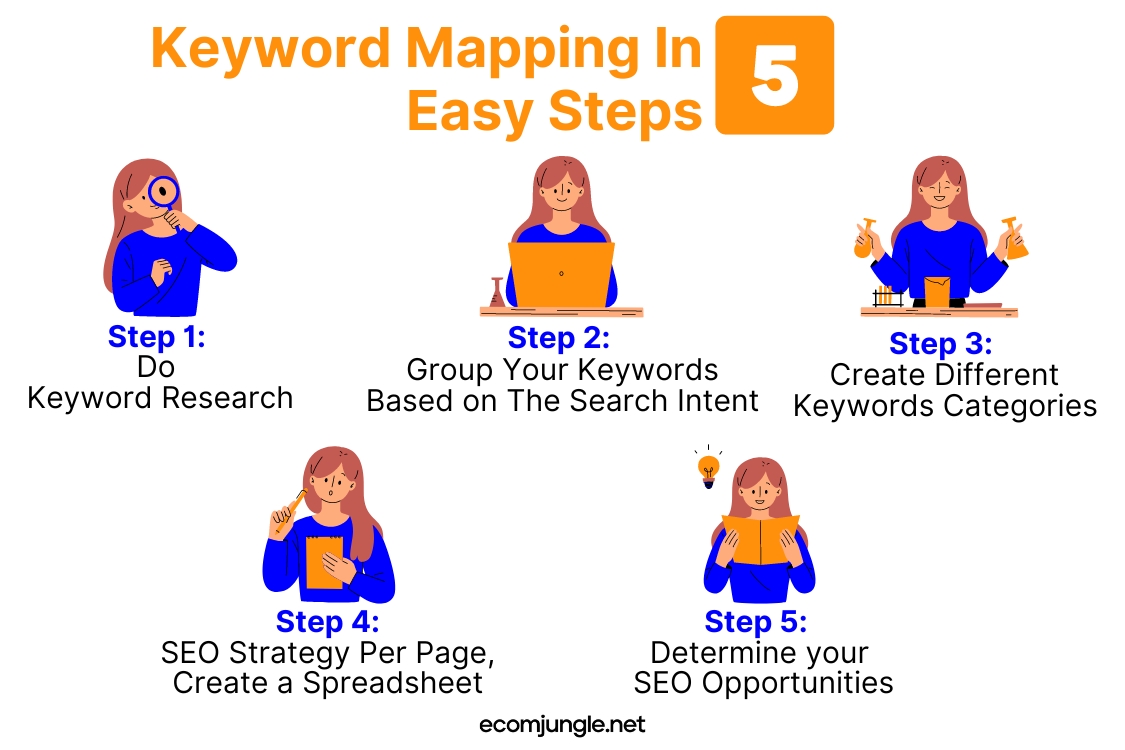
Now that you know the definition and main benefits of keyword mapping for your SEO strategy, it’s time to get down to work and see how to do it step-by-step.
Step 1: Do Keyword Research
You need to do keyword research in this first step of your keyword mapping process. It is the art of selecting and grouping the search terms you want your page to rank for in a search engine.
According to Webfx, 39% of marketers think keyword research is the most challenging part of SEO.

So to make finding search terms as easy as possible, you can use keyword research tools like SE Ranking, Semrush, Google keyword planner, KW finder, etc., to have a clearer view of keyword opportunities.
To use it, you need to enter the tool of your choice, go to the search bar, and enter the keyword idea you want to find according to your niche, topic, or business, for example, “kids’ clothe.”
To help you refine your search results, most of these tools allow you to filter results by search engines (Google, Bing, Yahoo, YouTube, Amazon, etc.), country or region, etc.
Once you click on search, you get a list of results with the key metrics, such as search volume, competition, CPC, organic traffic, impressions, and keyword difficulty index.
The best thing is that you will get suggestions of search terms, from short-tail keywords to more specific search terms, such as long-tail keywords, aligned to each topic.
Then export the list you have obtained and go to the next step!
Pro tip:
Before starting your keyword research, it is necessary that you previously set the objectives or goals you want to achieve, as this helps you to select the best options to align your actions with your strategy and results.
Step 2: Group Your Keywords Based on The Search Intent
Alright, you already have a long list of keyword options, but not all of them will serve the same purpose in your content marketing strategy; that’s why you should select and group keywords taking into account the user’s search intent behind them.
Remember those spreadsheets I suggested you create for your keyword mapping; start discarding confusing or ambiguous terms, which have little potential for conversion, not focus on low search volume or high competition. You must discard those terms that do not respond to the audience need you are looking to cover on your page.
Stay with viable search terms and align correctly with the angles you want to cover.
Let’s see what’s next!
Step 3: Create Different Keywords Categories
Now that you have narrowed down the list of keywords, it’s up to you to organize and rank them into categories and link them to your website’s appropriate URL.
I suggest that in your spreadsheet, you assign a color to each group and place the URL and the set of keywords for that page, including the main focus keyword and two or three variations.
Sort them according to search volume, competition, keyword difficulty, CPC, etc.
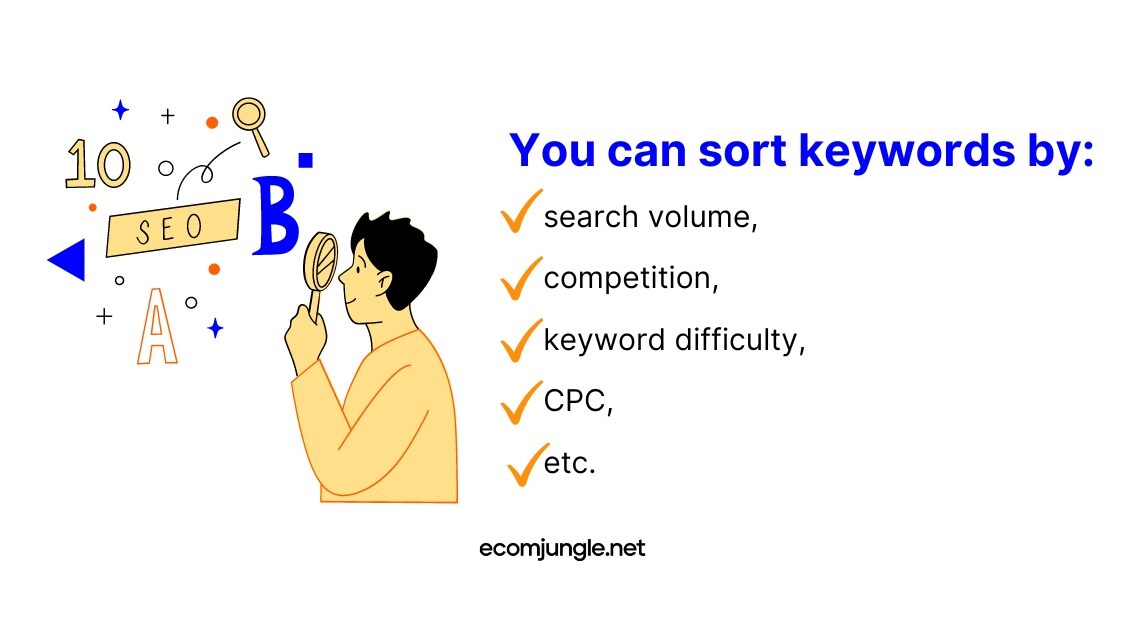
Step 4: SEO Strategy Per Page, Create a Spreadsheet
It’s time to give your SEO strategy for each page of your website, to define and align your content creation actions.
To do this, you must create a new spreadsheet, but this one will have more specifications to guide you and your team on the content you will develop.
Create different columns in each one, including:
- The name of the URL or page.
- The keywords you are going to have specifically for that page.
- The title you propose for that page.
- Also, add proposals for the H tags and the meta description.
The idea is that this sheet is the north to follow in creating your marketing strategy.
Step 5: Determine your SEO Opportunities
Finally, this step corresponds to looking at the SEO opportunities you have discovered throughout the process. In this case, that is, which of these unique keywords per page are viable and have a high ROI potential so that you can boost your SEO campaign?
It would be best if you chose those most likely to arouse your audience’s interest and have a direct relationship with your brand’s vision with the image you want to project to your customers.
A keyword map helps you evaluate the real opportunities and establish priorities to determine the way forward.
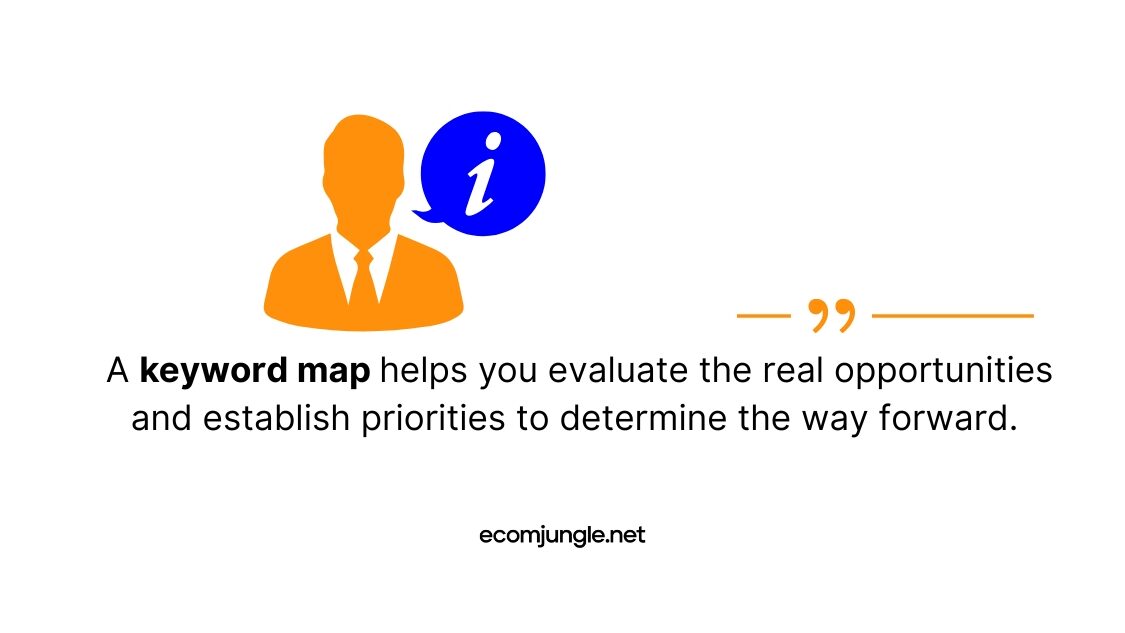
Some Tips To Keep In Mind When Doing Your Keyword Map
- Prevent keyword cannibalization: don’t assign the same keywords to more than one URL because you are making two pages of your website compete with each other.
- Examine search intent: you must make your map thinking about what your target audience is looking for. It helps you determine for what purpose users browse online and unveil why they want the content to choose your target keywords.
- Discover the logical and natural relationship between keywords: include words that fit naturally into your content, so it’s important to consider how you formulate those words.
- Don’t limit the use of your keywords to only page text: you can use search terms in other areas or sections to optimize your page, either by adding tags, search filters, categories, etc., and don’t just try to force them into the body of the page.
- See what you are missing: see what ranking opportunity you are not taking advantage of, what blind spot you have not covered or were taking for granted.
That’s All For today!
Creating a keyword map consists of grouping the keywords your potential customers use to search for you, assigning pages to those relevant keywords, and creating new page content to fill the gaps.
Mapping keywords will also help you determine the strategic direction of your marketing, clearly seeing which topics you have already addressed and which, although related, you have not considered.
Having, in one place, all the information about your pages and the keywords associated with them is a unique instrument that should be in your SEO arsenal.
Are you ready to start creating your keyword map? Want to know more?
Share your opinion in the comments box!
Frequently Asked Questions
Keyword mapping is important to create and define your SEO actions, campaigns, updates, or new content ideas. It also helps you to create a more robust web architecture for better search engine crawling.
It helps you organize your keywords hierarchically, group them according to search intent, and avoid content duplication and keyword cannibalization. Also, it allows you to design a robust architecture for your website and improve the communication of expectations of your strategy.